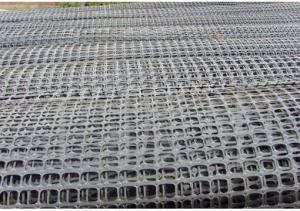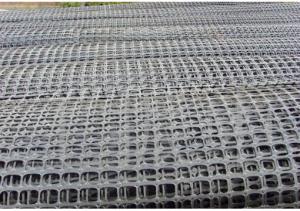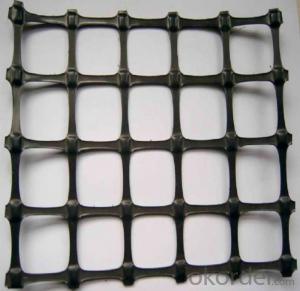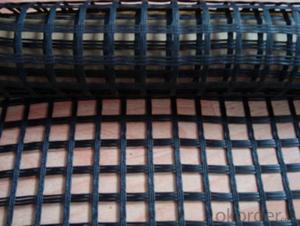HDPE Uniaxial Geogrid with High Tensile Strength for Retaining Wall/Road Consturction
- Loading Port:
- China Main Port
- Payment Terms:
- TT or LC
- Min Order Qty:
- 5000 Square Meters m²
- Supply Capability:
- 12000 Square Meters Per Week m²/month
OKorder Service Pledge
OKorder Financial Service
You Might Also Like
HDPE Uniaxial Geogrid with High Tensile Strength for Retaining Wall/Road Consturction
1. Main Introduction of HDPE Uniaxial Geogrid with High Tensile Strength for Retaining Wall/Road Consturction
In grade separation applications, Uniaxial Geogrids are used to help soils stand at virtually any desired angle; from 0 to 90 degrees. Geogrids can be combined with a wide variety of facing elements in retaining wall and slope applications to produce the desired structural or aesthetic conditions for any project.
Geogrid Reinforced Soil Retaining Walls:
Geogrid reinforced soil retaining walls offer economical and aesthetically pleasing alternatives to conventional retaining wall systems. The geogrid reinforced fill zone behind the wall facing acts as a uniform mass or block, providing stability to the wall and structure. Geogrids work with a wide variety of fill materials and facing elements including segmental concrete blocks, concrete panels, geogrid wraps, timbers or boulders.
Geogrid Reinforced Slopes:
Geogrid reinforced slopes provide a natural and economical alternative to conventional concrete retaining walls. Geogrid reinforced slopes create naturally finished slope structures that are easy to construct and enhance property values because of their natural beauty. Geogrid reinforced slopes can be built at any angle to provide the most economical use of available space while avoiding the increased cost of vertical structures.
The construction of embankments, bridge approach fills, dikes and causeways over soft soils and wetlands traditionally involves expensive, time consuming construction methods. Geogrid reinforcement of these structures minimizes the project footprint, fill requirements and differential settlement, saving time and money
2. Specifications and Technical Data of HDPE Uniaxial Geogrid with High Tensile Strength for Retaining Wall/Road Consturction
No. | Index properties | Test Method | Item(PEUG) | ||||||
60 | 80 | 120 | 160 | 180 | 200 | ||||
1 | Polymer | _ | HDPE | ||||||
2 | Minimum Carbon Black % | ASTM D4218 | 2 | ||||||
3 | Tensile Strength @ 2% Strain MD kN/m | ASTM D6637 | 16 | 23 | 35 | 47 | 52 | 58 | |
4 | Tensile Strength @ 5% Strain MD kN/m | 31 | 44 | 65 | 85 | 104 | 116 | ||
5 | Ultimate Tensile Strength MD kN/m | 60 | 80 | 120 | 160 | 180 | 200 | ||
6 | Strain @ Ultimate Strength % | 11.5 | 11.5 | 11.5 | 11.5 | 11.5 | 11.5 | ||
7 | Junction Efficiency % | GRI GG2-87 | 93 | 93 | 93 | 93 | 90 | 90 | |
8 | Flexural Rigidity mg-cm | ASTM D1388 | 1,400,000 | 2,300,000 | 7,700,000 | 19,000,000 | _ | _ | |
Durability | |||||||||
9 | UV Resistance % | ASTM D4355 | 98 | 98 | 98 | 98 | 98 | 98 | |
10 | Oxidation Resistance % | EN ISO 13438 | 100 | 100 | 100 | 100 | 100 | 100 | |
11 | Brittleness | WashDOT T926 | Pass | Pass | Pass | Pass | Pass | Pass | |
Reduction Factor | |||||||||
12 | Minimum Reduction Factor for | ASTM D5262 | 1 | _ | 1.02 | 1 | _ | _ | |
13 | Reduction Factor for Creep for | ASTM D5818 | 2.23 | 2.23 | 2.23 | 2.23 | 2.23 | 2.23 | |
Dimensions | |||||||||
14 | Roll Width m | _ | 1 | 1 | 1 | 1 | 1 | 1 | |
15 | Roll Length m | _ | 75 | 50 | 30 | 30 | 30 | 30 | |
16 | Roll Weight kg | _ | 30 | 27 | 23 | 29 | 33 | 36 | |
3. Some Photos of HDPE Uniaxial Geogrid with High Tensile Strength for Retaining Wall/Road Consturction
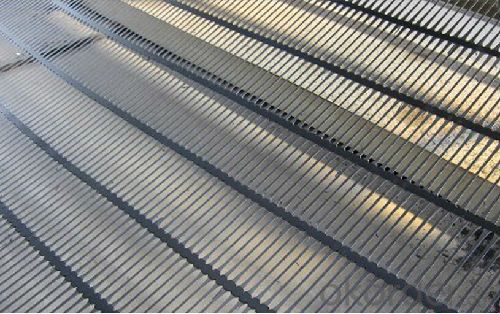
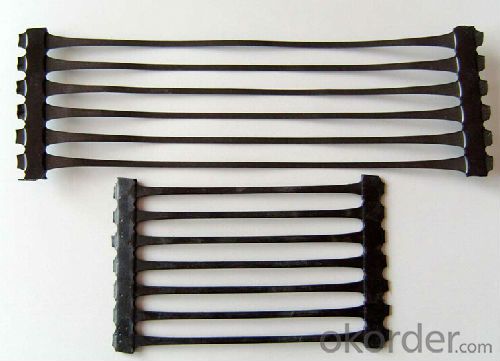
FAQ:
1. What's your payment terms?
T/T, L/C at sight
2. What's your delivery time?
Within 15days against deposit received
3/ What's your package?
WOVEN BAGS
- Q:Can geogrids be used in reinforcement of embankments on collapsible soils?
- Yes, geogrids can be used in the reinforcement of embankments on collapsible soils. Geogrids provide tensile strength and stability to the soil, preventing it from collapsing under the weight of the embankment. Additionally, they help distribute the load more evenly, reducing the risk of differential settlement.
- Q:Can geogrids be used in soil reinforcement for load-bearing platforms?
- Yes, geogrids can be effectively used in soil reinforcement for load-bearing platforms. Geogrids are engineered materials that provide soil stabilization and improve the load-bearing capacity of soils. They are typically made of high-strength polymers and have a grid-like structure that interlocks with the soil particles, creating a stable foundation. Geogrids distribute the applied loads more evenly, reducing the potential for soil settlement and enhancing the overall stability of load-bearing platforms.
- Q:Can geogrids be used in subgrade stabilization applications?
- Yes, geogrids can be used in subgrade stabilization applications. Geogrids are commonly used to reinforce and stabilize the soil in subgrade areas, improving its load-bearing capacity and reducing settlement. They are effective in stabilizing weak or soft soils, preventing lateral spreading, and enhancing the overall stability and performance of the subgrade.
- Q:What are the cost considerations for using geogrids in construction projects?
- Some cost considerations for using geogrids in construction projects include the initial cost of purchasing and installing the geogrids, the potential cost savings in reducing the amount of traditional materials needed, the cost of maintenance and repair over time, and the overall long-term cost-effectiveness compared to alternative construction methods.
- Q:The price of the type of geogrid manufacturers is the best phone
- Thermal stability - the melting temperature of the glass fiber is above 1000 DEG C, which ensures the stability of the fiberglass geogrid in the paving operation.
- Q:How do geogrids affect soil compaction?
- Geogrids can improve soil compaction by enhancing the load-bearing capacity of the soil. They act as a reinforcement layer, distributing the applied loads more evenly, reducing soil movement, and preventing excessive settlement. This helps to maintain a more uniform and stable soil structure, increasing its compaction and overall strength.
- Q:How do geogrids improve the performance of geocells?
- Geogrids improve the performance of geocells by providing additional reinforcement and stabilization. They enhance the load-bearing capacity of geocells, improve soil confinement, and prevent lateral movement and deformation. Geogrids also distribute applied loads more evenly, reducing stress on the geocell walls and increasing overall stability.
- Q:What is the effect of aging on geogrid properties?
- The effect of aging on geogrid properties is generally a decrease in mechanical strength and stiffness. Over time, exposure to environmental factors such as sunlight, temperature variations, and moisture can cause degradation of the geogrid material, leading to reduced tensile strength, increased elongation, and diminished load-bearing capacity. The aging process can also result in changes to the geogrid's chemical composition and surface morphology, impacting its ability to interlock with surrounding soil particles and retain its original design characteristics. Therefore, it is crucial to consider the potential effects of aging when designing geogrid-based structures and to periodically assess their condition to ensure their long-term performance.
- Q:How many Chinese geogrid manufacturers? How many famous
- In foreign markets, the high level of the grid, it is basically the competition with TANSER
- Q:Can geogrids be used in reinforcement of pavement overlays?
- Yes, geogrids can be used in the reinforcement of pavement overlays. Geogrids are commonly used as a reinforcement material in pavement construction to enhance the strength and durability of the pavement structure. They are placed between layers of pavement materials to distribute loads and reduce cracking, rutting, and other forms of pavement distress. Geogrids help to improve the overall performance and lifespan of pavement overlays.
1. Manufacturer Overview |
|
|---|---|
| Location | 示范:Hebei, China |
| Year Established | 示范:1997 |
| Annual Output Value | 示范:Above US$50 Million |
| Main Markets | 30.00% South America; 20.00% North America; 15.00% Eastern Europe; 15.00% Southeast Asia; 10.00% South Asia; 5.00% Southern Europe; 5.00% Africa |
| Company Certifications | ISO 9001:2008 |
2. Manufacturer Certificates |
|
|---|---|
| a) Certification Name | |
| Range | |
| Reference | |
| Validity Period | |
3. Manufacturer Capability |
|
|---|---|
| a)Trade Capacity | |
| Nearest Port | Tianjin;Qingdao;Shanghai |
| Export Percentage | |
| No.of Employees in Trade Department | 21-50 People |
| Language Spoken: | English;Chinese |
| b)Factory Information | |
| Factory Size: | Above 100,000 square meters |
| No. of Production Lines | Above 12 |
| Contract Manufacturing | OEM Service Offered;Design Service Offered |
| Product Price Range | High;Average |
Send your message to us
HDPE Uniaxial Geogrid with High Tensile Strength for Retaining Wall/Road Consturction
- Loading Port:
- China Main Port
- Payment Terms:
- TT or LC
- Min Order Qty:
- 5000 Square Meters m²
- Supply Capability:
- 12000 Square Meters Per Week m²/month
OKorder Service Pledge
OKorder Financial Service
Similar products
New products
Hot products
Hot Searches
Related keywords
